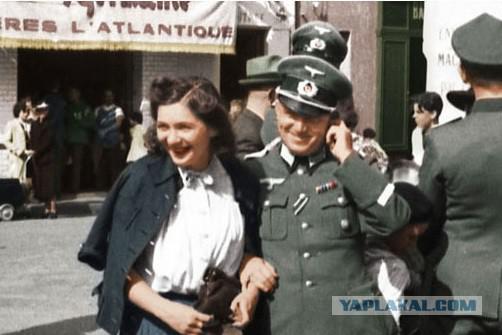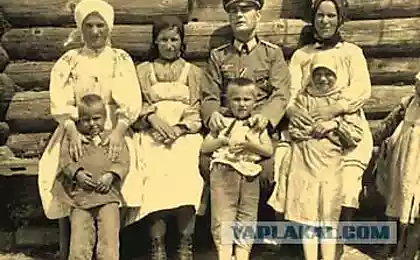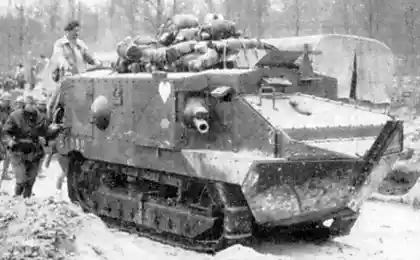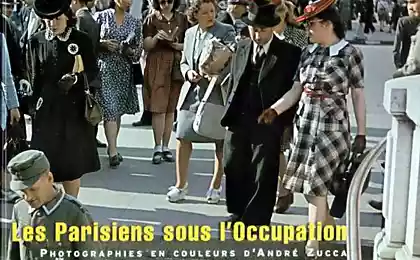1766
Europe during the German occupation
As Europe lived during the German occupation
Radically reshaping the map of Europe during World War II, the Germans were very selective approach to its population. If one immediately sent to concentration camps, the other for the time allowed to enjoy life.

Nazi "EU»
Already in the first weeks of the occupation of Europe, the Nazis began to set in her "new order", which included various forms of addiction: from vassal (Hungary or Romania) - open to annexation (part of Poland and Czechoslovakia). Ultimately, political and geographical borders of Europe were to be dissolved in Greater Germany, and some nations - razed to the ground. The Nazi version of the European Union provides different relationship to the enslaved countries. This was due to their "ethnic purity", the cultural level and the degree of resistance provided by the occupation authorities. Under such conditions, predominantly Slavic population of Eastern Europe is well behind Western neighbors.
If, for example, did not annex the territory of Poland was declared a German "governor-generalship", the self-governing Southern France collaborationist regime "Vichy". However, not always in Western Europe, the Nazi regime was a success. In the Netherlands and Belgium, the German agents were too weak, and therefore the German proteges Mussert and Degrel popularity among the population did not use. In Norway, according to statistics, only 10% of residents supported the occupation authorities. Perhaps this is due to persistence of Scandinavians Reich created a special program to "improve the gene pool," in which several thousand Norwegian women had children of German soldiers.

Europe without war
If the western territory of the USSR turned into a continuous battle, the life of a significant part of Europe differed little from peace. In European cities, cafe, museums, theaters, places of entertainment, people went shopping and resting in a park. The only thing that catches the eye is the presence of German troops and signs in German. Especially in this plan was indicative of Paris, which the Germans appreciated because of the possibility of a relaxing holiday and fun entertainment.
By Rivoli sported fashionista and cabaret without weekends entertained local and visiting public. More than a hundred institutions in Paris were specially opened for the service of soldiers of the Wehrmacht. "I've never been so happy," - confessed mistress of one of the brothels. In general, German policy in France was flexible and encouraged. Intellectual and artistic elite here gave room for the activities envisaged for certain concessions to various French institutions. So, if the Germans from other countries in huge quantities exported values and antiques, then, for example, the Louvre reserved the right to prohibit the export of any work of art in Germany.
Without any restrictions, a French film industry. During the years of occupation in France were produced 240 feature films and 400 documentaries and animated many years, exceeding production of Germany itself. Note that it was during the war talent blossomed future stars of world cinema - Jean Marais and Philip Gerard.
There were, of course, certain difficulties associated with wartime. For example, many Parisians for butter and milk had to travel to the village, some food items was issued coupons, and some restaurants serve only the Germans, as a ban on free sale of radios. However, these restrictions do not go to any comparison with life in most cities of Eastern Europe.

Working days
Europe as a raw material appendage of Germany to work in full force since the early days of the war - almost all of its resources were switched to maintenance of relics of the Third Reich and to provide a rear base in the confrontation with the Soviet Union. Austria gave iron ore, Poland - coal, Romania - oil, Hungary - bauxite and iron pyrite, Italy - lead and zinc. A large role in this play and human resources. In one of the confidential notes of the German officer kept requirement "for most types of work, is a simple, primitive and secondary" active use "auxiliary peoples' predominantly Slavic origin.
To meet the needs of the Wehrmacht in many parts of Europe opened branches of German companies - "Krupp", "Siemens", "IG Farbenindastri" reoriented local factories such as "Schneider-Creusot" in France. However, if the conditions of the workers of Western Europe were quite tolerable, their eastern counterparts labored to wear, to give the promised Hitler arrived, which "did not know the story." For example, the average period of the employees in the Polish factory "Bunaverk" not exceeding two months, every three weeks was conducted inspection of the workers, which resulted in weakened patients and sent to the crematorium, and their place is occupied by new victims of this monstrous conveyor death.

Ghetto
The Jewish Ghetto is one of the unique layers of life of Europeans during the Nazi occupation, and at the same time an example of the amazing adaptability and survival in extremely adverse conditions. Depriving the Jews not only all the values and savings, but also the minimum livelihood, the German authorities have isolated them in closed areas of some major European cities. Own life it is difficult to call. Jews are usually settled by several families in one room - the average population density in the "cleared" under the ghetto neighborhoods in 5-6 times higher than previous figures. Jews are forbidden to almost everything - trade, engage in crafts, learn and even move freely.
Nevertheless, through holes in fences teens penetrated the city and mined much needed residents 'quarantine area' food and medicine. The largest ghetto was Warsaw, where lived for at least half a million people. Its inhabitants, despite the prohibitions, managed to not only survive, but also to get an education, to conduct cultural life and even arrange leisure. It turned out the Warsaw ghetto hearth of the biggest anti-fascist resistance in Poland. German authorities to suppress the uprising of the Warsaw Jews spent almost more effort than to conquer Poland itself.

Concentration camps
In occupied countries by the German model the new government have created a network of concentration camps, the number of which, given the current data, more than 14 000 points. Here in intolerable conditions contained about 18 mln., Of whom 11 million. Was destroyed.
For example, take the camp Salaspils (Latvia). Prisoners huddled by 500-800 people in cramped barracks, their daily ration consisted of a 300-gram piece of bread mixed with sawdust and a cup of soup of vegetable waste. The working day usually lasted less than 14 hours. But the Germans created and Exemplary camps that were supposed to show the world the German "progressive and humane." This was the Czech "Theresienstadt". The camp contained mostly European intellectuals - doctors, scientists, musicians, artists. For some prisoners created a family barracks. At the camp functioned houses of worship, library and theater, exhibitions and concerts were held. However, the fate of many people "Theresienstadt" was sad - their life ended in the gas chambers of Auschwitz.
hence

Radically reshaping the map of Europe during World War II, the Germans were very selective approach to its population. If one immediately sent to concentration camps, the other for the time allowed to enjoy life.

Nazi "EU»
Already in the first weeks of the occupation of Europe, the Nazis began to set in her "new order", which included various forms of addiction: from vassal (Hungary or Romania) - open to annexation (part of Poland and Czechoslovakia). Ultimately, political and geographical borders of Europe were to be dissolved in Greater Germany, and some nations - razed to the ground. The Nazi version of the European Union provides different relationship to the enslaved countries. This was due to their "ethnic purity", the cultural level and the degree of resistance provided by the occupation authorities. Under such conditions, predominantly Slavic population of Eastern Europe is well behind Western neighbors.
If, for example, did not annex the territory of Poland was declared a German "governor-generalship", the self-governing Southern France collaborationist regime "Vichy". However, not always in Western Europe, the Nazi regime was a success. In the Netherlands and Belgium, the German agents were too weak, and therefore the German proteges Mussert and Degrel popularity among the population did not use. In Norway, according to statistics, only 10% of residents supported the occupation authorities. Perhaps this is due to persistence of Scandinavians Reich created a special program to "improve the gene pool," in which several thousand Norwegian women had children of German soldiers.

Europe without war
If the western territory of the USSR turned into a continuous battle, the life of a significant part of Europe differed little from peace. In European cities, cafe, museums, theaters, places of entertainment, people went shopping and resting in a park. The only thing that catches the eye is the presence of German troops and signs in German. Especially in this plan was indicative of Paris, which the Germans appreciated because of the possibility of a relaxing holiday and fun entertainment.
By Rivoli sported fashionista and cabaret without weekends entertained local and visiting public. More than a hundred institutions in Paris were specially opened for the service of soldiers of the Wehrmacht. "I've never been so happy," - confessed mistress of one of the brothels. In general, German policy in France was flexible and encouraged. Intellectual and artistic elite here gave room for the activities envisaged for certain concessions to various French institutions. So, if the Germans from other countries in huge quantities exported values and antiques, then, for example, the Louvre reserved the right to prohibit the export of any work of art in Germany.
Without any restrictions, a French film industry. During the years of occupation in France were produced 240 feature films and 400 documentaries and animated many years, exceeding production of Germany itself. Note that it was during the war talent blossomed future stars of world cinema - Jean Marais and Philip Gerard.
There were, of course, certain difficulties associated with wartime. For example, many Parisians for butter and milk had to travel to the village, some food items was issued coupons, and some restaurants serve only the Germans, as a ban on free sale of radios. However, these restrictions do not go to any comparison with life in most cities of Eastern Europe.

Working days
Europe as a raw material appendage of Germany to work in full force since the early days of the war - almost all of its resources were switched to maintenance of relics of the Third Reich and to provide a rear base in the confrontation with the Soviet Union. Austria gave iron ore, Poland - coal, Romania - oil, Hungary - bauxite and iron pyrite, Italy - lead and zinc. A large role in this play and human resources. In one of the confidential notes of the German officer kept requirement "for most types of work, is a simple, primitive and secondary" active use "auxiliary peoples' predominantly Slavic origin.
To meet the needs of the Wehrmacht in many parts of Europe opened branches of German companies - "Krupp", "Siemens", "IG Farbenindastri" reoriented local factories such as "Schneider-Creusot" in France. However, if the conditions of the workers of Western Europe were quite tolerable, their eastern counterparts labored to wear, to give the promised Hitler arrived, which "did not know the story." For example, the average period of the employees in the Polish factory "Bunaverk" not exceeding two months, every three weeks was conducted inspection of the workers, which resulted in weakened patients and sent to the crematorium, and their place is occupied by new victims of this monstrous conveyor death.

Ghetto
The Jewish Ghetto is one of the unique layers of life of Europeans during the Nazi occupation, and at the same time an example of the amazing adaptability and survival in extremely adverse conditions. Depriving the Jews not only all the values and savings, but also the minimum livelihood, the German authorities have isolated them in closed areas of some major European cities. Own life it is difficult to call. Jews are usually settled by several families in one room - the average population density in the "cleared" under the ghetto neighborhoods in 5-6 times higher than previous figures. Jews are forbidden to almost everything - trade, engage in crafts, learn and even move freely.
Nevertheless, through holes in fences teens penetrated the city and mined much needed residents 'quarantine area' food and medicine. The largest ghetto was Warsaw, where lived for at least half a million people. Its inhabitants, despite the prohibitions, managed to not only survive, but also to get an education, to conduct cultural life and even arrange leisure. It turned out the Warsaw ghetto hearth of the biggest anti-fascist resistance in Poland. German authorities to suppress the uprising of the Warsaw Jews spent almost more effort than to conquer Poland itself.

Concentration camps
In occupied countries by the German model the new government have created a network of concentration camps, the number of which, given the current data, more than 14 000 points. Here in intolerable conditions contained about 18 mln., Of whom 11 million. Was destroyed.
For example, take the camp Salaspils (Latvia). Prisoners huddled by 500-800 people in cramped barracks, their daily ration consisted of a 300-gram piece of bread mixed with sawdust and a cup of soup of vegetable waste. The working day usually lasted less than 14 hours. But the Germans created and Exemplary camps that were supposed to show the world the German "progressive and humane." This was the Czech "Theresienstadt". The camp contained mostly European intellectuals - doctors, scientists, musicians, artists. For some prisoners created a family barracks. At the camp functioned houses of worship, library and theater, exhibitions and concerts were held. However, the fate of many people "Theresienstadt" was sad - their life ended in the gas chambers of Auschwitz.
hence
























